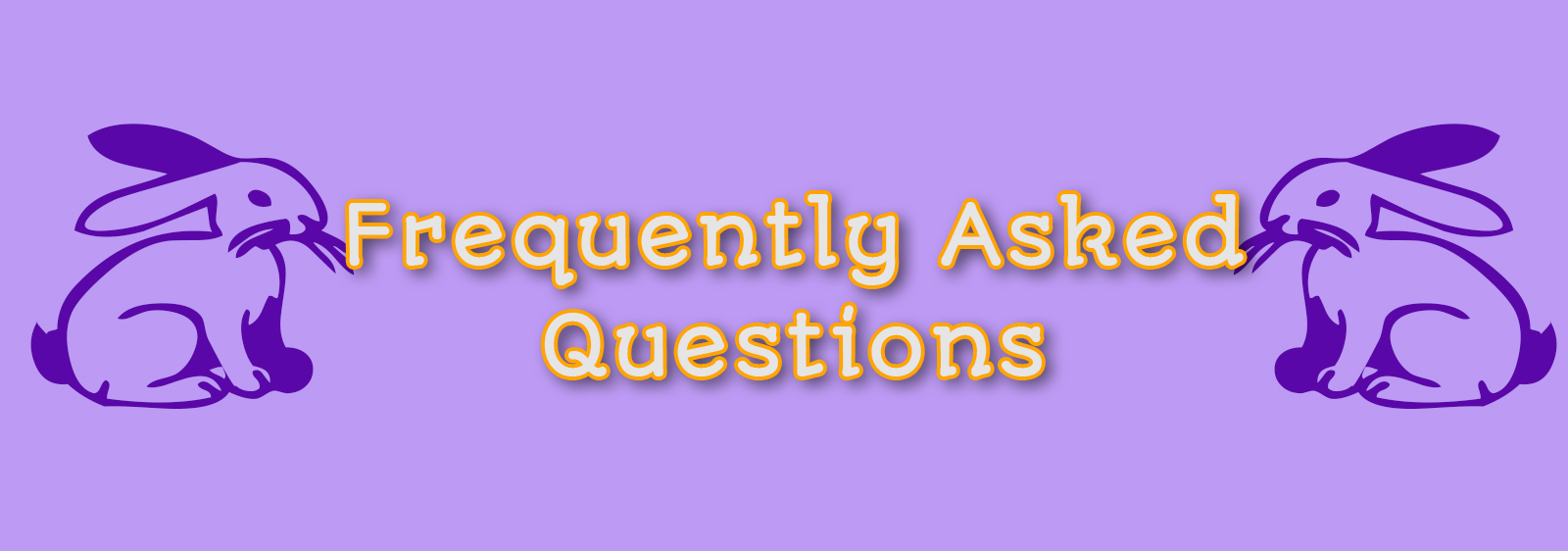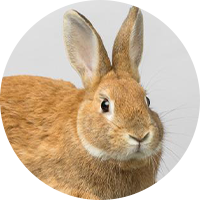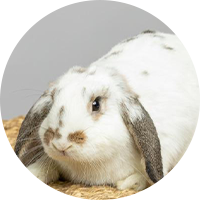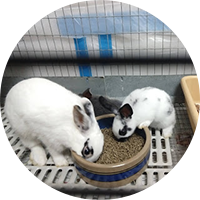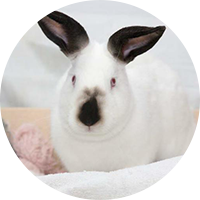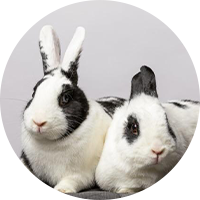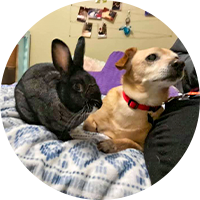Frequently Asked Questions
Frequently Asked Questions
General
Because we are a private shelter run solely by volunteers, we do not have the ability to handle drop-in visitors.
Even if you are unsure about adopting a rabbit just yet (or ever), we ask that you fill out our adoption application so that our adoption coordinator can schedule a shelter visit appointment with you to come see all of our rabbits.
For Bunny Boutique Store hours, please visit our Bunny Boutique Store.
Because we are a private shelter with limited volunteer hours, we do not disclose our physical shelter address to prevent possible “drop-offs” of rabbits when we are not there to take them in. If you need our address for any of the below reasons, please see their linked pages for more information:
Surrendering a Rabbit
Found a Rabbit
Volunteering
Bunny Boutique Shop
Can’t Find the Answer To Your Question? Contact Us.
Frequently Asked Questions
Adoption FAQ's
The adoption process starts by completing our Online Adoption Application. Please visit our Adoption Procedure page to learn more.
Because we are a private shelter run solely by volunteers, we do not have the ability to handle drop-in visitors.
Even if you are unsure about adopting a rabbit just yet (or ever), we ask that you fill out our adoption application so that our adoption coordinator can schedule a shelter visit appointment with you to come see all of our rabbits.
Depending on a number of factors, it can take from 2-3 days to 2-3 weeks. Please see our Adoption Procedure page to learn more.
The fee to adopt is $95 for a single rabbit and $125 for a bonded pair/triplet.
You will be required to sign an adoption contract. The adoption fee includes a packet of educational materials (as well as on-going support). We encourage you to also purchase needed rabbit supplies at the time of adoption at our Bunny Boutique.
The fee we charge only partially covers our expense of having the rabbit spayed or neutered, vetted fully, dewormed, microchipped, and vaccinated, as well as for expenses incurred during the time the rabbit is in our care (this can be years). HRRN rarely recovers the costs associated with spaying/neutering and caring for a shelter rabbit via our adoption fee.
Many first time adopters want suggestions on cages, accessories, food, etc. This is part of the service we provide when you are approved to adopt a rabbit from HRRN. We encourage you not to purchase any items or supplies—especially a cage—without speaking to us first.
Many cages available in pet stores are not large enough to accommodate bunny and all accessories, or pose other problems (such as ease of cleaning). Many are pretty to look at (and expensive) but in the long run prove problematic. We can make suggestions for everything your rabbit will need and where to purchase. Plus, if you purchase from our Bunny Boutique at the time of adoption, you help support our shelter rabbits and rescue efforts! You may order a custom cage from HRRN at the time your application has been approved so it will be ready when you bring home your new rabbit companion. The cages we build and sell are affordable and extremely functional as opposed to many “designer” cages available in stores or online. Plus, we make sure you get the right size for your rabbit(s).
To learn more about rabbit care, look through our Rabbit Care Information & Resources on this site. We’ve tried to include pretty much everything you need to know about living with a house rabbit.
House rabbits are not easy pets. They are not children’s pets. They require an educated owner who understands the intricacies of their care so that they are able to offer the rabbit the best forever home possible. Rabbits are a 10 to 15 year commitment, and at HRRN, we believe that if someone finds it to be too much work to fill out a 15-20 minute application and go through a 45 minute phone screening to adopt a companion rabbit that will be part of their lives for the next 10-15 years, then they will not have the commitment of time and love needed to give the rabbit the care s/he deserves.
The rabbits we care for have ALL been abandoned in one way or another; they are quite literally “second-hand” animals. The absolute LEAST we can do is to ensure their next home will be their last – a happy and safe home at that, and ensuring their new family knows how to properly and humanely care for them. Remember, that which is easy or free is never valued as much as that which one must work for. HRRN (as well as other rabbit resource groups) have a wealth of knowledge and experience – available at your fingertips! We encourage you to partake of this.
Browse this website to learn about all the different things about caring for a house rabbit. From Diet, to Housing, to Behavior, we’ve got you covered, or have links to other resources that have it covered! If you adopt a rabbit from us and utilize social media, we encourage all adopters to join our adopter resource group on Facebook. This group is where you can ask any and all rabbit questions, shares stories, photos, and updates on your adopted bun, and be a part of our adopter community.
House Rabbit Resource Network believes that rescue groups and local shelters are the best places to get a pet rabbit. When you adopt a rabbit from a rescue organization like HRRN, you are giving an “orphaned” rabbit a second chance at life in a caring, well-prepared home. Plus, when you adopt, you save the lives of two rabbits: the one you adopt and the one who takes his or her place. To learn more, please see our adopt a rabbit page to see the benefits of adopting a rabbit.
Pet stores, feed stores and backyard breeders (whether they be your family, friends, neighbors, or some stranger on Craigslist), continue the vicious cycle of rabbit overpopulation and homelessness. These people and places account for most of the rabbits dropped off at shelters, abandoned in the wild, or caged outside in small, lonely backyard hutches, often receiving minimal care and no attention.
A rabbit acquired from such a source is more likely to live a short, sickly life. Many are born with congenital problems from over-bred mothers, which produce weak babies. Many bunnies are prematurely weaned. In addition, these rabbits experience stress from handling and changes in diet and location.
Accurate care information or ongoing support from stores or breeders is rare if nonexistent.
Due to owner’s lack of knowledge or correct information, many rabbits die or are abandoned once they have passed that “cute baby” stage or when they become an inconvenience to people unfamiliar with their needs.
Most first time rabbit adopters are happier with an adult rabbit that has outgrown unruly adolescent behavior. Socialized adult rabbits are usually available only through an adoption program.
Every rabbit acquired from a breeder or retailer denies a home to a rabbit that needs one. Or, to put it bluntly, for every rabbit purchased from one of these sources, a rabbit at an animal shelter may lose it’s life.
Can’t Find the Answer To Your Question? Contact Us.
Frequently Asked Questions
Bunny Bonding FAQs
The initial process to adopt a rabbit friend for your rabbit is pretty much the same as the normal adoption process. Fill out an online adoption application –> phone call with our adoption team member–> meet and greet at the shelter —except you bring your bunny to do a form of speed dating. Once we find a rabbit that both you and your rabbit like (along with some alternatives), we will set up the bonding process—this can take a week to three depending. Keep in mind it is ultimately up to the rabbits to choose each other, not us.
The process takes place in our facility or possibly, one of our bunny bonding volunteers’ homes. You will be required to leave your rabbit with us during this time (to some this is very scary, we completely understand and will be happy to send regular updates via phone or email to set you at ease—your bunny will be in very good, knowledgeable hands). If the bonding is successful, you will take the new happy pair home once our bunny bonding volunteer feels it is complete and safe to do so. If the bonding fails—some relationships just don’t work out—we will restart the bonding process with one of the alternative shelter rabbit picks from the meet and greet. Depending on the individual rabbits, bunny bonding can take some time. Some rabbits are very picky on who they choose as a partner, don’t get discouraged!
It is also important to understand your rabbit must be spayed or neutered prior to pairing. Despite the fact all of our shelter rabbits are fixed prior to adoption, we will not consider adoption to a home with an unaltered rabbit (Why? See our Spay/Neuter Information and Resource Page).
Please note: we charge a $50 pairing fee to cover the cost of supplies and for our time while the rabbits are being paired.
Our pairing fee is $50 on top of the normal adoption fee.
The requirements that must be met for your bunny to find a friend are:
- Your rabbit must be spayed or neutered. If they are not yet, but you plan to in the near future, it is fine to go ahead and fill out an adoption application, but we will need to wait 6 weeks from the day of the surgery to allow all the hormones to leave your bunnies system to ensure the best possible scenario for when your bunny meets the other bunnies for a possible friendship.
- Your rabbit must live inside your home. All of our adopters are required to house their rabbits indoors, we will not adopt out any rabbit to someone who keeps their rabbits outside (to see why that is, check out Why Outside is No Place for a House Rabbit.
Yes! We encourage anyone wanting to bond their rabbits, whether one is an HRRN rabbit or not, to please contact us for assistance. We have dedicated and experienced Bunny Bonders who will either do the bonding themselves, or help you do it every step of the way. We do charge a $50 bonding fee.
All of our shelter rabbits are spayed and neutered to prevent adding to the overpopulation problem, as well as because unfixed rabbits are notorious for having attitude and behavior problems.
Unfixed rabbits can be extremely aggressive towards people or the other rabbit they live with. Rabbits are surprisingly vicious for being so adorable, and if a fight is not broken up , one rabbit can be severely injured or killed.
There are thousands of accounts of aggressive rabbits biting large chunks of flesh out of they’re owner’s hands or feet/ankles.
Unfixed rabbits of the opposite sex WILL breed. Rabbits will continuously breed until one no longer can.
Unfixed rabbits of the same gender normally don’t get along. They can be very territorial of their space, and will hurt anyone they perceive as a threat to that territory. Spraying very stinky urine is another way they show their territory.
Litter box training is also very difficult with unfixed rabbits.
To ensure all rabbits have a happy, friendly relationship with their rabbit buddy, having both rabbits fixed is the number one essential way to ensure that happens.
Learn more about the benefits and reasons behind Spaying and Neutering your rabbit. Need help finding a rabbit savvy vet to spay or neuter your rabbit? Visit our Rabbit-savvy Veterinarians page.
It is not uncommon for bonded rabbits to get in the occasional tiff. Sometimes bonded rabbits break out in a fight after years of happy companionship. If your rabbits get in a fight, separate them and check for the possible cause. We don’t always know the cause, but suspects are:
- A new rabbit arriving in the household (whether you are trying to bond another rabbit to your current two or three, or even if you just bring home a new rabbit to stay separate. They still know a new rabbit is in the house!)
- A trip to the vet or some other situation where rabbits are separated and/or pick up a strange new smell.
- A health problem that makes the sick bunny irritable or the healthy one anxious. It’s always a good idea to have both bunnies checked by your rabbit-savvy vet after a fight occurs to make sure there’s not a new, underlying illness.
Once any health problems are addressed or ruled out by your veterinarian, go back to bonding basics if there is still tension in the relationship. If they continue to fight, or the fights are escalating, separate the rabbits and please do not hesitate to contact us for assistance.
Warning Signs that a fight may be about to start:
Aggressive behaviors:
- Tail up
- Ears back
- Growling
- Boxing
- Circling
- Chasing and biting (rabbits do not “play fight”)
If one of these behaviors occurs several times in a row; if neither rabbit backs down; or if it leads to further aggressive behaviors, it should be interrupted.
Ways to Interrupt a fight about to happen, or during a fight:
A spray of water, aimed at the rabbits’ heads, may interrupt a fight about to happen but has no effect once anger is aroused.
If a fight advances to a clench, use a towel to separate the rabbits. Or, pour water from a water bowl on them. Using your hands is asking for a skin-breaking bite. Yelling can also stop them mid-fight and allow you time to separate them.
Once their separated, take a break and revise your strategy.
Some rabbits can become un-bonded all together. Sometimes, especially if the bond was made early in life when one or both rabbits was pre-adolescent, once they mature into teenagers or adulthood it’s found that just like in humans, the rabbits no longer are friends. These un-bonding fights are usually VERY aggressive at the start. It’s not just a little irritating nip here or a circle there, it’s an all out, drag out fight. If you suspect that your rabbits have had a fight that is worthy of them feeling they no longer are friends, please keep them separated and contact us to help. Sometimes, there is no going back from an un-bond. However, that doesn’t mean that the rabbits will be unhappy living as singles side by side with a fence in between them, or that they can’t find new friends.
Can’t Find the Answer To Your Question? Contact Us.
Frequently Asked Questions
Rabbit Care FAQs
This website! We’ve done our best to include as much information about caring for house rabbits as possible on here, or giving you resources to other reliable house rabbit websites. If you’d like a quick overview about owning a rabbit and rabbit care, check our Rabbit Care 101 page. To see all the different articles provided on this website, check out our Rabbit Care Information & Resources page. If you have a specific question you can’t find an answer to, feel free to contact us.
Can’t Find the Answer To Your Question? Contact Us.
Frequently Asked Questions
Rabbits & Pellets
In short, yes. If your rabbit normally eats all their pellets, and then one day doesn’t, they could be sick. One of the main signs of sickness in rabbits is uninterest in the food they normally love.
You can try the Cranraisin test by offering a Cranraisin (dried cranberry) to your rabbit. If they deny it, they are most likely sick–possibly gut stasis, and you need to get them to a veterinarian ASAP.
If they eat the Cranraisin, but are still avoiding their other food, they could be suffering teeth problems and avoiding what’s hurting them. You still need to get them to the vet asap.
If your rabbit stops eating their pellets, it is cause for alarm and you should seek veterinary attention.
Some rabbits are grazers and don’t eat all their pellets in one sitting, but the pellets should be all eaten by the end of the day. If you see leftover pellets, watch for a few days, if it keeps occurring, you may need to look at re-adjusting their portion size.
If your rabbit eats all their pellets, that’s great! That does not mean you need to feed them more before the next day’s serving—bunnies can have weight problems by overeating just like humans.
Over feeding of pellets is the cause of many health problems in rabbits. An overweight rabbit is probably more in need of exercise than having their food limited. Should your rabbit need to lose weight or develop an intolerance to pellets (symptoms include excessive cecal pellets or chronic diarrhea), please contact your veterinarian for assistance.
**Warning: If you see your rabbit who regularly eats all their pellets doesn’t touch them all day, check their temperature and contact your veterinarian because it could be the first sign of gut stasis.
Storage is important for your rabbit’s pellets to keep their freshness and prevent from spoiling.
Moisture is the enemy when storing forage-based pellets (which is what rabbit pellets are made of—timothy hay). To decrease the risks of decomposition and mold development, pellets should be kept in a cool, dry environment, preferably in a container tightly closed to seal out moisture, insects, or rodents.
Just as with forage, oxidation affects short-lived vitamins, particularly B-vitamins such as biotin. You want to store the pellets somewhere dry.
If you find your pellets seem moldy, bug infested, stale, old, or off-smelling pellets should be discarded immediately.
Can’t Find the Answer To Your Question? Contact Us.
Frequently Asked Questions
Rabbits and Other Animals
To learn more about this subject visit out Rabbits and Other Animals page
There are certain breeds that are more likely to have high-prey drives, and therefore are more likely to have difficulties coexisting with a rabbit. However, each animal is an individual, so you cannot simply say: any dog in this breed can’t get along with a rabbit, or vice versa. You’ll need to assess your dog with the questions up in our Rabbits and Other Animals page to get a better understanding of your dog’s individual predatory drive.
With that being said, here is a database of dog breeds with information that can be useful: Dog Breeds
As each animal is an individual, some rabbits will never feel safe around a dog. That being said, the anxiety could very well be coming from the most likely over-the-top hyper puppy energy. Obedience training with the puppy before introduction is key. Possibly get a dog trainer to assist. Once the puppy has all their commands down pat, then you can consider trying to introduce again via the introduction steps in Rabbits and Other Animals page.
This is a tough situation. Something obviously triggered the dog. We recommend reaching out to a dog trainer to do an assessment. There could be something in the environment setting the dog off that the trainer can find and help remove or train around. But until then you need to separate the dog and rabbit.
Dog obedience training is key to successful introductions, as well as the personality assessment for level of prey-drive. If the dog is deemed to be on the low-prey drive side, and once they respond immediately to all obedience commands, you can begin the introduction steps described on the Rabbits and Other Animals page.
Can’t Find the Answer To Your Question? Contact Us.

